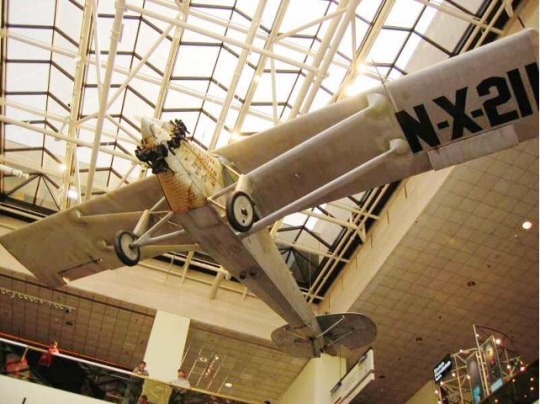When I see Quetzalcoatlus northropi soaring above the Cretaceous in Dinosaurs in Their Time, I’m often reminded of the Spirit of St. Louis suspended aloft at the Smithsonian National Air and Space Museum. It might sound strange that a pterosaur from 70 million years ago would bring to mind an icon of twentieth century flight, but Q. northropi is a perfect starting point for exploring modern aviation history and the interconnections between nature and aeronautical engineering.

When I was first introduced to Q. northropi, I knew it was named after the Mesoamerican feathered serpent god Quetzalcoatl, but I assumed the northropi part came from the name of the paleontologist who discovered the great pterosaur’s remains. I soon found to my surprise that the specific name northropi was bestowed in honor of Jack Northrop, the aeronautical engineer who experimented with flying wing aircraft designs in the 1940s. When the pterosaur was discovered in Big Bend National Park in the early 1970s by graduate student Douglas A. Lawson from the University of Texas at Austin, Lawson and his advisor were struck by its size (adults could grow as large as a giraffe), wingspan (up to 36 feet), and its lack of a tail. The last of these three features made Northrop a natural namesake for the species. As the fantastic news of Quetzalcoatlus spread in 1975, the journal Science unveiled one of its most memorable cover pages: depicted on the cover of its mid-March issue to dramatic effect is a Northrop flying wing aircraft (think the grandfather of the Stealth bomber), Quetzalcoatlus, a Pteranodon (with a puny wingspan of only 18 feet), and a condor (looking like a harmless sparrow in comparison). From the moment of its discovery in Far West Texas, Quetzalcoatlus northropi captured the imagination of both the paleontological and aviation communities and does so to this day.
The tailless design of Northrop’s flying wing allowed for better fuel efficiency and increased aerodynamics compared to traditional airplane designs. Debate, however, has raged over whether or not Quetzalcoatlus’s anatomy allowed the creature its own advantage in flight…or if it could fly at all. The jury is still out on the particulars of Q. northropi’s flying ability. Recent theorizing, from the mind of paleontologist Michael Habib, has the pterosaur capable of perhaps short flights powered by quadrupedal take-off as opposed to bipedal take-off, the method used by birds. Regardless of the debate, Q. northropi has itself inspired experimentation in drone technology. In 1985, at the behest of the Smithsonian, engineer Paul MacCready and a team of fellow scientists built and tested an orthocopter modeled after Quetzalcoalus with a modified wingspan of 18 feet. While the project was not without its technical hiccups, the team successfully test-flew their human-constructed pterosaur over Death Valley that year. This drone, called QN, is now housed at the Smithsonian National Air and Space Museum and remains an ambitious and fascinating example of how scientists attempt to fathom the biomechanics of extinct species. With this in mind, maybe it isn’t so strange that I’ve imagined Quetzalcoatlus and the Spirit of St. Louis in the same thought after all.

While Q. northropi’s flying skills remain ambiguous, its namesake’s design is indeed found directly in nature. Northrop’s flying wing shares its form and function with the seeds of the Javanese flying cucumber (Alsomitra macrocarpa), a fruit-bearing vine found in Southeast Asia. When its fruit, football-sized gourds, have ripened they release their seeds from high in the canopy of the rainforest. These seeds, light-weight, papery in texture, and shaped like flying wings glide to the ground sometimes several hundred meters away using autogyration to guide and slow their descent; this is the same phenomenon, for example, that guides maple trees’ “whirligig” seeds, known scientifically as samaras, to the ground. Nature is full of designs and forms that aeronautical engineers mine for the advancement of flight technology. Paul MacCready, when lecturing before an esteemed audience at MIT, once called dragonflies, hummingbirds, and hawk moths “nature’s helicopters.” Happily, each of those animals will be common in Southwestern Pennsylvania when spring and summer finally return. So, whether you’re marveling at Quetzalcoatlus northropi any time of year at the Carnegie Museum of Natural History or taking a leisurely walk at your local park, you’ll be able to ponder with renewed attention the interconnections between the natural world and the science of aviation.

Nicholas Sauer is a Gallery Experience Presenter in CMNH’s Life Long Learning Department. Museum staff, volunteers, and interns are encouraged to blog about their unique experiences and knowledge gained from working at the museum.
Works Cited
Bryner, Jeanna. “How Huge Flying Reptiles Got Airborne.” Livescience.com. 7 Jan. 2009. <https://www.livescience.com/3190-huge-flying-reptiles-airborne.html>.
Carlson, Mark. “Northrop’s Radical Flying Wing Bomber of the 1940s.” July 2020. <https://www.historynet.com/northrops-radical-flying-wing-bomber-of-the-1940s.htm>.
MacCready, Paul and John Langford. “Human-Powered Flight: Potentials.” MIT Gardner Lecture, 27 April 1998. MIT Video Productions. <https://www.youtube.com/watch?v=t8C8-BB_7nw>.
Miller, David. “It’s A Bird; It’s a Plane; It’s a…Cucumber?” Boston University. 25 Nov. 2012. <http://blogs.bu.edu/bioaerial2012/2012/11/25/the-stabilizing-characteristics-of-alsomitra-macrocarpa/>.
“Texas Pterosaur Flies into Spotlight this National Fossil Day.” The University of Texas at Austin, Jackson School of Geosciences. 17 Oct. 2018. <https://www.jsg.utexas.edu/news/2018/10/texas-pterosaur-flies-into-limelight-this-national-fossil-day/>.
Related Content
Super Science: She-Ra, the American Kestrel
